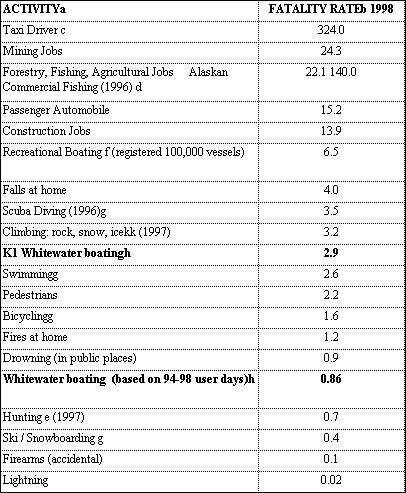 |
 |
 |
 |
 |
 |
|




































|
|
 |
AW Safety Report

Whitewater Boating is
Safer than You Think
Whitewater tragedies tend to
generate excessive amounts of press, even though they occur
fairly infrequently. This creates an illusion of the sport
as unsafe. Reality, however, paints a different picture of
risk. In fact, a new study by American Whitewater finds that
the fatality rate for whitewater recreation is 15 times
lower than driving and twice as safe as bicycling. It is
also much safer than recreational boating as a whole.
The good news is that the risks of whitewater paddling are
quite manageable and are mitigated through training, use of
a personal floatation device (PFD), and development of good
personal judgment. The drive to the river is probably the
most dangerous part of any whitewater trip.
American Whitewater has just completed a five-year study to
determine the risk of drowning from whitewater boating. We
collected use data from 30 whitewater rivers of various
difficulties from across the country. The result: less than
1 fatality per 100,000 whitewater participants. The complete
study will be printed in the September/October issue of
American Whitewater.
As Jason Robertson, Access Director, observed, “While
whitewater drownings are tragedies of a very personal nature
for the victim's family and friends, these accidents,
fortunately, are rare. Most paddlers will never encounter a
serious accident at any time in their boating career.”
Among whitewater kayakers, who have a higher accident rate
compared to canoers and rafters, the fatality rate is only
2.9 per 100,000 participants. When compared to other active
outdoor sports, kayaking is safer than scuba diving (3.5)
and climbing on rock, snow, or ice (3.2).
7,420,563 whitewater boaters visited the 30 rivers in our
5-year study period between 1994 and 1998. Of these, there
were 5,732,683 commercial boaters and 1,687,880 private
boaters. During this same period there were 64 whitewater
boating fatalities, including 26 commercial passenger deaths
and 38 private boater deaths. We calculated that there were
0.86 whitewater fatalities per 100,000 participants, or 2.25
private boater deaths per 100,000 and 0.45 commercial boater
deaths per 100,000. The river with the most whitewater
fatalities was the Arkansas in Colorado, with 17 drownings
over five years.
The overall whitewater fatality rate based on user days
would be even lower if we could obtain more accurate data on
the number of private boaters. Whereas commercial rafting
companies were required to turn in passenger manifests each
season, private use counts were collected by river
management agencies via a wide variety of registration
systems over different monitoring seasons, and private use
counts often included self-guided trips in rented boats as
private visitors.
Lee Belknap, Chair of American Whitewater’s Safety
Committee, observed that “Safety in the sport is related
to experience, training, and personal judgment. However, the
ONE item that makes the single greatest contribution to
personal safety on the water is the use of a life jacket or
personal floatation device (PFD).” Although not really a
problem among experienced whitewater paddlers or passengers
on professionally guided raft trips, American Whitewater has
found that improper use of a PFD (including the failure to
wear one on the water) is responsible for at least half of
all fatalities in both flat and moving water.
Charlie Walbridge, another American Whitewater Safety
Committee member and author of many swiftwater safety books,
agreed with Belknap, saying “Life jackets truly save
lives. Whether you are kayaking across a lake, floating your
canoe on a pond, or rafting the Class V Gauley River, you
can cut your chances of drowning in half by properly wearing
your PFD.“
1998 Fatality Rates (b)
in the United States:

a Unless otherwise noted,
statistics are from National Safety Council (1999). Injury
Facts.
b Fatality rate per 100,000 participants (except Lightning,
Falls, Fires, Drowning, Motor Vehicles, Pedestrians, and
Firearms, which are per 100,000 population).
c National Institute for Occupational Safety and Health
“Identifying High-Risk Small Business Industries” (May
1999) DHHS (NIOSH) Publication No. 99-107.
d National Institute for Occupational Safety and Health
“Commercial Fishing Fatalities in Alaska” (1997) DHHS (NIOSH)
Publication No. 97-163.
e Matthews, John (1998). Alaska Hunting Bulletin. Alaska
Department of Fish and Game
f U.S. Coast Guard.
g National Sporting Goods Association (1998, 1997). Sports
Participation. As reported in “NSAA Report on
Skiing/Snowboarding Safety.” (October 1999). http:/www.skinet.com/instruction/00/983.html.
h Wittmann, Laura (Sept. / Oct. 2000). “Whitewater Boating
Fatality Study.” American Whitewater Journal.
i United States Fire Administration (1998). “Fire Fighter
Fatalities in the United States, 1998.” National Fire Data
Center.
j FBI Clarksburg, WV. As quoted in Ovenshine, Gordon. (May
7, 2000). “Police Fatalities Decrease.” Pittsburgh
Tribune-Review.
k The American Alpine Club (1998). 1998 Accidents in North
American Mountaineering.
kk Williamson, Jedd. Editor of Accidents in North American
Mountaineering. Phone Conversation July 12, 2000.
l Plyler, Jennifer. (2000). “Comparison of American
Whitewater Safety Statistics to the U.S. Coast Guard.”
Unpublished Data. American Whitewater Safety Assistant.
mSporting Good Manufacturers Association (SGMA) and the USDA
Forest Service. Cordell, Ken, McDonald, Barbara &
Briggs, J. Alden. (1995). Emerging Markets for Outdoor
Recreation in the United States based on the National Survey
on Recreation and Environment. www.outdoorlink.com/infosource.nsre.

for more information please contact:
Jason Robertson
American Whitewater Access Director
American Whitewater
1430 Fenwick Lane
Silver Spring, MD 20910
301-589-9453
301-589-6121 (fax)
Email:
jason@amwhitewater.org
Released August 31, 2000
|
 |
|
 |
|
 |
 |
 |
|


